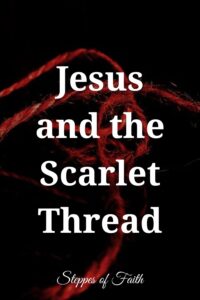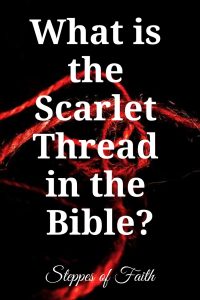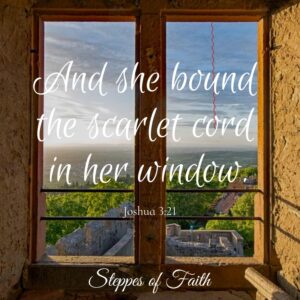
“And she bound the scarlet cord in the window.” (Joshua 3:21)
The Bible contains several stories involving a scarlet thread, but a larger symbolic one flows throughout the Old and New Testaments, signifying God’s plan of redemption.
The scarlet thread appears right away in the book of Genesis and the story of Adam and Eve. God required a blood sacrifice because they sinned by eating the fruit. So He made atonement by killing an innocent animal and clothing Adam and Eve with its skin. The sacrifice is not solely out of love but also as a representation of how He covers our sin with His righteousness (Genesis 3:21). Pastor Ernest Angley explains it this way:
“Man had tried to cover himself after he sinned; he sewed fig leaves together, but without shedding of blood there is no remission (Heb 9:22). Without the shedding of blood, man has no covering to blot out his sins from the sight of God. The blood of the Son of God is the only way the sins of man could be washed away.”
God’s plan of redemption was already in motion even before Adam and Eve ate the fruit. He did not want to separate from His finest creation, but He could not (and still will not) tolerate sin in His perfect, holy presence; therefore, He required a sacrifice.
Because God is life and the penalty for sin is death, only a perfect sacrifice could reconcile us to Him. So, He sent His only son to pay the debt of sin for us all.
Abraham’s Scarlet Thread
The scarlet thread appears again in Genesis 22 when God commanded Abraham to sacrifice his son Isaac. While climbing Mount Moriah together, Isaac asked his father, “Look, the fire and the wood, but where is the lamb for a burnt offering?” Abraham replied, “My son, God will provide for Himself the lamb (v7-8).”
Once at the summit, Abraham bound Isaac and laid him on the wood. Just as he raised his knife to kill his son, God called to him, saying,
“Do not lay your hand on the lad or do anything to him. For now I know that you fear God since you have not withheld your son, your only son, from Me.” (Gen 22:12)
Abraham then “lifted his eyes” and saw a ram caught by its horns in a nearby bush. God spared Isaac’s life because of Abraham’s obedience, prompting Abraham to name the site “Jehovah Jireh,” which means “The LORD Will Provide.”
God provided a ram to shed its blood to save Isaac’s life. The event foreshadows and parallels Jesus’ sacrifice in the New Testament gospels. He is the Lamb who was the perfect sacrifice to take away the sins of the world (John 1:29).
Tying a Scarlet Thread
Genesis 38:27-30 reflects the scarlet thread again with the story of Judah (one of Jacob’s sons and brother to Joseph) and his wife, Tamar, who gave birth to twins. One twin stuck his arm out of the birth canal, so the midwife tied a scarlet thread around his wrist to help Tamar know which twin was born first.
“Then it happened, as he drew back his hand, that his brother came out unexpectedly, and [the midwife] said, ‘How did you break through? This breach be upon you!’ Therefore, his name was called Perez. Afterward, his brother came out who had the scarlet thread on his hand, and his name was called Zerah.”
Technically, Zerah was born first, but because Perez was the first to come fully out of Tamar, he was the one who was called firstborn. And it was through Perez’s family that Jesus was eventually born.
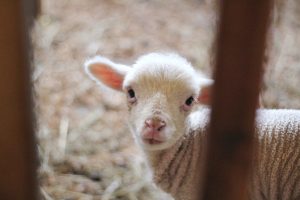
Blood of the Lamb
The scarlet thread continues in Exodus 12 when God instituted the first Passover.
God instructed Moses to tell the Hebrews to sacrifice a spotless lamb and put its blood on the door frames of their houses as a sign that believers were inside. When the Lord passed through the land and saw the blood, He “passed over” those houses and killed those who did not obey. The Jewish people continue to celebrate Passover each year in commemoration of God’s deliverance from Pharaoh and Egyptian slavery.
Once again, a lamb’s blood protected the people from death while foreshadowing the coming of the Lord Jesus Christ.
Following the Jewish people’s miraculous deliverance, God commanded the people to establish a temple overseen by Levite priests (Ex 25-27). Exodus 28:5-8 describes the priest’s ephod, which must include a scarlet thread (v8); likewise, Exodus 26:31 describes the temple’s curtains.
In both cases, scarlet represents blood, but not just any blood. It specifically points to the prophecy of Jesus’ death on the cross and the blood He shed for our sins.
Rahab and the Spies
Probably the most familiar story of a scarlet thread is found in Joshua 2:17-20 in which Rahab the harlot hides two Hebrew spies from the king of Jericho. The king and his pursuers immediately began searching for them because they knew the Israelites were coming to conquer the city.
Before the spies escaped, they swore to protect Rahab and her household from the pursuers if she kept a scarlet cord in her window.
“And whoever is with you in the house, his blood shall be on our head if a hand is laid on him.” (Josh 2:19)
Rahab kept her oath, and the Israelite army spared her family from the utter destruction Jericho later endured when the walls fell (Joshua 6). Some years later, she married a man named Salmon, and together, they had a son named Boaz (Ruth 4:21), whose grandson eventually became a famous king of Judah.
Just as the Hebrews covered their door frames with blood, Rahab covered her house by putting the scarlet cord in her window. God protected her because she believed by faith in the power the cord represented, which is God’s deliverance. Similarly, He delivers us through our faith in His Son, Jesus.
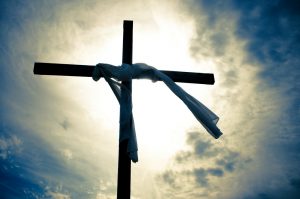
The Scarlet Thread in Every Book
The scarlet thread continues through the Bible, winding through the Lord Jesus’ lineage and the events leading to His virgin birth. New Testament authors Matthew and Luke trace His ancestry—Matthew covers Jesus’ father’s family history, and Luke covers His mother’s family. Both apostles recorded amazing heroes of the Christian faith, including Abraham, Isaac, Jacob, Judah, and Boaz, who were on both sides of Jesus’ family.
The other more notable people on Jesus’ father’s side are:
- Abraham, Isaac, and Jacob
- Judah (one of Jacob’s sons; note that the scarlet thread does not flow through his other son, Joseph)
- Boaz, his wife Ruth, and their son, Jesse
- King David (Jesse’s son), Bathsheba, and their son, Solomon
- King Rehoboam
- King Jehoshaphat
- King Hezekiah
- King Josiah
- Joseph, Jesus’ earthly father
The more notable people on Jesus’ mother’s side are:
- Adam and his son, Seth
- Enoch
- Abraham, Isaac, and Jacob
- Judah
- Lamech and his son, Noah
- Seth, Noah’s son
- Boaz, his son Obed, and his grandson, King David
- Nathan, one of King David’s other sons
The scarlet thread flows legally through Joseph’s family while it flows physically through Mary’s, and both lines intersect at King David. Luke 3:23 mentions Joseph as “the son of Heli,” who was Mary’s father, but he includes Joseph in the lineage due to marriage and because Heli had no sons of his own.
Note that the scarlet thread does not include other famous figures like Moses, Joshua, Elijah, Samuel, Sampson, Esther, or any prophets. It only involves Jesus’ royal line and His physical descent, which God established to preserve Jesus’ royalty and purity as He walked to the cross.
The scarlet thread runs through every book of the Bible. It begins in Genesis, flows into the New Testament through the gospel accounts, and remains alive until Jesus’s victorious return, as described in Revelation. Until then, believers remain thankful for God’s redemption plan and the people representing each strand that makes the thread so vital to us all.
